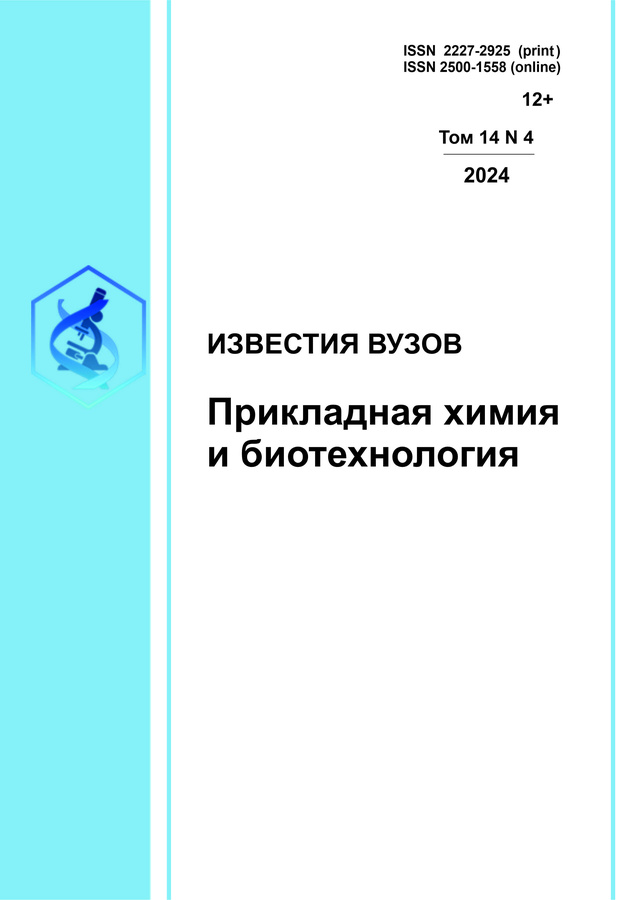Получение наночастиц mcl-полигидроксиалканоатов, стабилизированных неионогенным детергентом Tween 80
- Авторы: Зубков И.Н.1,2, Высочинская В.В.1,3, Кашина А.В.4, Шишлянников С.М.1,3
-
Учреждения:
- Научно-исследовательский институт гриппа им. А.А. Смородинцева Минздрава России
- Всероссийский научно-исследовательский институт пищевых добавок – филиал «ФНЦ Пищевых систем им. В.М. Горбатова» РАН
- Санкт-Петербургский политехнический университет Петра Великого
- Институт высокомолекулярных соединений РАН
- Выпуск: Том 13, № 3 (2023)
- Страницы: 454-460
- Раздел: Краткие сообщения
- URL: https://bakhtiniada.ru/2227-2925/article/view/301369
- DOI: https://doi.org/10.21285/2227-2925-2023-13-3-454-460
- EDN: https://elibrary.ru/MUMYAI
- ID: 301369
Цитировать
Полный текст
Аннотация
Ключевые слова
Об авторах
И. Н. Зубков
Научно-исследовательский институт гриппа им. А.А. Смородинцева Минздрава России; Всероссийский научно-исследовательский институт пищевых добавок – филиал «ФНЦ Пищевых систем им. В.М. Горбатова» РАН
Email: zub-i@bk.ru
В. В. Высочинская
Научно-исследовательский институт гриппа им. А.А. Смородинцева Минздрава России; Санкт-Петербургский политехнический университет Петра Великого
Email: veravv2509@gmail.com
А. В. Кашина
Институт высокомолекулярных соединений РАН
Email: kashina.anna@mail.ru
С. М. Шишлянников
Научно-исследовательский институт гриппа им. А.А. Смородинцева Минздрава России; Санкт-Петербургский политехнический университет Петра Великого
Email: sershilin@gmail.com
Список литературы
- Gagliardi A., Giuliano E., Venkateswararao E., Fresta M., Bulotta S., Awasthi V., et al. Biodegradable polymeric nanoparticles for drug delivery to solid tumors // Frontiers in Pharmacology. 2021. Vol. 12. P. 601–626. https://doi.org/10.3389/fphar.2021.601626.
- Herrera D.A., Ashai N., Perez-Soler R., Cheng H. Nanoparticle albumin bound-paclitaxel for treatment of advanced non-small cell lung cancer: an evaluation of the clinical evidence // Expert Opinion on Pharmacotherapy. 2019. Vol. 20, no. 1. P. 95–102. https://doi.org/10.1080/14656566.2018.1546290.
- Safdar R., Omar A.A., Arunagiri A., Regupathi I., Thanabalan M. Potential of chitosan and its derivatives for controlled drug release applications – a review // Journal of Drug Delivery Science and Technology. 2019. Vol. 49. P. 642– 659. https://doi.org/10.1016/j.jddst.2018.10.020.
- Maity S., Chakraborti A.S. Formulation, physicochemical characterization and antidiabetic potential of naringenin-loaded poly D, L lactide-co-glycolide (N-PLGA) nanoparticles // European Polymer Journal. 2020. Vol. 134. P. 109818. https://doi.org/10.1016/j.eurpolymj.2020.109818.
- Maksimenko O., Malinovskaya Yu., Shipulo E., Osipova N., Razzhivina V., Arantseva D., et al. Doxorubicinloaded PLGA nanoparticles for the chemotherapy of glioblastomas: towards the pharmaceutical development // International Journal of Pharmaceutics. 2019. Vol. 572. P. 118733. https://doi.org/10.1016/j.ijpharm.2019.118733.
- Lu X.-Yu., Li M.-C., Zhu X.-L., Fan F., Wang L.-L., Ma J.-G. Microbial synthesized biodegradable PHBHHxPEG hybrid copolymer as an efficient intracellular delivery nanocarrier for kinase inhibitor // BMC Biotechnology. 2014. Vol. 14. P. 4. https://doi.org/10.1186/1472-6750-14-4.
- Hu J., Wang M., Xiao X., Zhang B., Xie Q., Xu X., et al. A novel long-acting azathioprine polyhydroxyalkanoate nanoparticle enhances treatment efficacy for systemic lupus erythematosus with reduced side effects // Nanoscale. 2020. Vol. 12. P. 10799–10808. https://doi.org/10.1039/D0NR01308K.
- Prakash P., Lee W.-H., Loo C.-Ye., Wong H.S.J., Parumasivam T. Advances in polyhydroxyalkanoate nanocarriers for effective drug delivery: an overview and challenges // Nanomaterials. 2022. Vol. 12, no. 1. P. 175. https://doi.org/10.3390/nano12010175.
- Miu D.M., Eremia M.C., Moscovici M. Polyhydroxyalkanoates (PHAs) as biomaterials in tissue engineering: production, isolation, characterization // Materials. 2022. Vol. 15, no. 4. P. 1410. https://doi.org/10.3390/ma15041410.
- Sehgal R., Gupta R. Polyhydroxyalkanoate and its efcient production: an eco-friendly approach towards development // 3 Biotech. 2020. Vol. 10. P. 549. https://doi.org/10.1007/s13205-020-02550-5.
- Jacquel N., Lo C.-W., Wu H.-S., Wei Yu-H., Wang S.S. Solubility of polyhydroxyalkanoates by experiment and thermodynamic correlations // Thermodynamics. 2007. Vol. 53, no. 10. P. 2704–2714. https://doi.org/10.1002/aic.11274.
- Axelson O. Chlorinated hydrocarbons and cancer: epidemiologic aspects // Journal of Toxicology and Environmental Health. 1980. Vol. 6, no. 5-6. P. 1245–1251. https://doi.org/10.1080/15287398009529943.
- Reddy V.U.N., Ramanaiah S.V., Reddy M.V., Chang Yo.-C. Review of the developments of bacterial medium-chain-length polyhydroxyalkanoates (mcl-PHAs) // Bioengineering. 2022. Vol. 9, no. 5. P. 225. https://doi.org/10.3390/bioengineering9050225.
- Shirmard L.R., Javan N.B., Khoshayand M.R., Kebriaee-zadeh A., Dinarvand R., et al. Nanoparticulate fingolimod delivery system based on biodegradable poly(3hydroxybutyrate-co-3-hydroxyvalerate) (PHBV): design, optimization,characterization and in-vitro evaluation // Pharmaceutical Development and Technology. 2017. Vol. 22, no. 7. P. 860–870. https://doi.org/10.3109/10837450.2015.1108982.
- Pachiyappan S., Selvanantham D.S., Kuppa S.S., Chandrasekaran S., Samrot A.V. Surfactant-mediated synthesis of polyhydroxybutyrate (PHB) nanoparticles for sustained drug delivery // IET Nanobiotechnology. 2019. Vol. 13, no. 4. P. 414–425. https://doi.org/10.1049/iet-nbt.2018.5053.
- Ravichandran V., Lee M., Cao T.G.N., Shim M.S. Polysorbate-based drug formulations for brain-targeted drug delivery and anticancer therapy // Applied Sciences. 2021. Vol. 11, no. 19. P. 9336. https://doi.org/10.3390/app11199336.
- Зубков И.Н., Букин Ю.С., Сорокоумов П.Н., Шишлянников С.М. Получение полигидроксиалканоата с помощью культуры Pseudomonas helmanticensis в нестерильных средах, содержащих глицерин и додецилсульфат натрия // Известия вузов. Прикладная химия и биотехнология. 2022. Т. 12. N 3. С. 479–484. https://doi.org/10.21285/2227-2925-2022-12-3-479-484. EDN: HFSIOR.
- Rebocho A.T., Pereira J.R., Freitas F., Neves L.A., Alves V.D., Sevrin C., et al. Production of medium-chain-length polyhydroxyalkanoates by Pseudomonas citronellolis grown in apple pulp waste // Applied Food Biotechnology. 2019. Vol. 6, no. 1. P. 71–82. http://dx.doi.org/10.22037/afb.v6i1.21793.
- Thakkar M., Brijesh S. Physicochemical investigation and in vivo activity of anti-malarial drugs co-loaded in Tween 80 niosomes // Journal of Liposome Research. 2018. Vol. 28, no. 4. P. 315–321. https://doi.org/10.1080/08982104.2017.1376684.
- Prabha S., Arya G., Chandra R., Ahmed B., Nimesh S. Effect of size on biological properties of nanoparticles employed in gene delivery // Artificial Cells, Nanomedicine, and Biotechnology. 2016. Vol. 44, no. 1. P. 83–91. https://doi.org/10.3109/21691401.2014.913054.
- Arechabala B., Coiffard C., Rivalland P., Coiffard L.J.M., de Roeck-Holtzhauer Y. Comparison of cytotoxicity of various surfactants tested on normal human fibroblast cultures using the neutral red test, MTT assay and LDH release // Journal of Applied Toxicology. 1999. Vol. 19, no. 3. P. 163–165. https://doi.org/10.1002/(SICI)10991263(199905/06)19:33.0.CO;2-H
Дополнительные файлы











